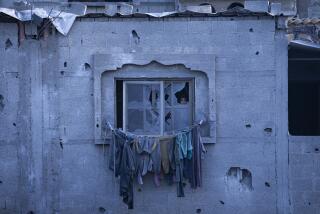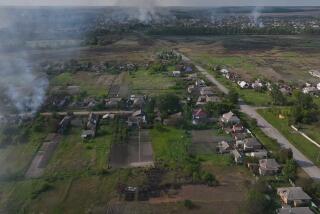In Grozny, Death Lingers Amid Rubble : Chechnya: Scattered ordnance and disease haunt breakaway republic’s capital city.
- Share via
GROZNY, Russia — For a child, this war-wrecked city is a fascinating and dangerous playground. Where else could skinny, curious boys like Shamikhan Mashtakhov and Beslan Magamadov find a grenade launcher lying in the street?
“It was one of those green tubes, and it had a red button. I said, ‘What’s this red button for?’ and I pushed it,” said Beslan, 13.
The grenade roared out of the tube, burning and cutting Beslan’s left arm and hand.
The exhaust from the rear of the tube caught his friend Shamikhan, 14, in the chest, lifting him off his feet and slamming him into a pile of rubbish. Both boys underwent surgery at a tent hospital; Beslan’s mangled hand was saved, but Shamikhan lost his right arm below the shoulder, and his blackened eyes squint in pain from internal chest injuries.
“I wanted to keep the war away, but the war found us all the same,” said Shamikhan’s mother, Heidi Mashtakhov, who fled Grozny during the fiercest assault by Russian forces and returned only days before the accident, when she believed that the city was safe for her son.
Since war descended 3 1/2 months ago on Grozny, the capital of the breakaway republic of Chechnya, more than 20,000 civilians--including 3,700 children--have been killed, according to preliminary estimates.
However desperate the Kremlin may be to end the conflict quickly, protracted fighting, diseases and unexploded mines will probably keep killing people for months or years to come.
Fighting has now swept south, into Chechnya’s grassy flatlands, and Grozny lies stunned and forgotten. But normal life has not returned to the city’s rubble-strewn streets, where residents are still counting the dead and searching for the missing.
Estimates of the death toll vary wildly. The new mayor of Grozny, Moscow appointee Beslan Gantamirov, insists that 4,000 city dwellers have been killed.
“It’s a guess,” he admitted--and one to the Kremlin’s liking.
But sociologists working separately for the Russian Duma’s Committee for Defense and for President Boris N. Yeltsin’s ousted human rights commissioner, Sergei A. Kovalev, estimate that about 25,000 civilians died. Their figures are based on surveys of the city’s population and of refugees who fled Grozny during the bombing.
“You can’t come up with an exact figure under conditions like those, but it’s in the ballpark,” said Murray Feshbach, a Georgetown University professor who has done groundbreaking work on demographics in Russia. “Whether it’s 22,000 or 25,000, what’s the difference? It’s still a pretty unpleasant figure.”
One thing is certain: The death toll is climbing.
Russian forces continue to bomb outlying villages in an indiscriminate campaign that kills more civilians than fighters. Rebels led by President Dzhokar M. Dudayev wage a retreating guerrilla war, while Dudayev himself has threatened to launch terrorist attacks against Russian cities in retaliation.
In largely pacified Grozny, thousands of civilians who had hid for months in basement shelters are emerging into the sunlight--and facing new dangers.
“Many of those who have survived the war so far will soon die of sickness,” said Alexander Chenlyaev, a blond-bearded doctor at a Grozny tent hospital set up by Russia’s Emergency Situations Ministry. “A person who lies in a basement, wounded, for a month often can’t be helped.
“We now expect cholera and diphtheria,” he said. “And as people come out of the basements, they are stepping on mines.”
Those too weak to walk or hitch rides to a hospital are largely on their own.
The city’s population is now estimated at 150,000, from a prewar 400,000, but three Russian Red Cross workers are the only people making house calls. And with the threat of mines ever-present, even they are loath to enter wrecked buildings in search of survivors or corpses.
“Only the dogs go into the basements,” said Vladimir Silvestorov, a Red Cross worker. He was referring to the hundreds of stray dogs that roam Grozny’s streets and are reputed to be eating neglected corpses--a rumor that has become fact in most people’s minds.
Stray dogs aside, many basements are certainly filled with corpses. They died there from wounds, or from illnesses fed by hunger and cold, or from direct bomb hits on their shelter. Or they were dragged there from city streets by survivors who could not bury them because of relentless bombing.
The haphazard fashion in which the dead have been collected makes a precise casualty count impossible.
About 1,000 bodies--the unidentified and the unidentifiable--have been buried by the Russian government in two mass graves. Other dead have been buried by survivors wherever possible: in courtyards, in parks, in city squares. Still others were carried by relatives back to their hometowns, to be buried next to ancestors. Batches of fresh graves have swelled sleepy village cemeteries throughout the republic.
The survivors are left to their daily struggles. There are no soup kitchens in Grozny. There is no warm food to be had anywhere. Civilians live off bread and canned meat from the Emergency Situations Ministry, which also trucks in water from nearby streams.
Those with money can shop at sad little open-air markets where the selection, drawn from prewar stocks, is always the same: cigarettes and Snickers bars, bread delivered as humanitarian aid and soft drinks of obscure origin with names such as “Big Cola” and “American Orange.”
“But no one has any money to shop there,” said Dr. Abdulgonin Magamadov, who with two other doctors runs one of the city’s only functioning hospitals. “We sell what we had before the war. I had a suit, and I sold it for bread for my wife and six children.”
Some Russian soldiers share their rations with locals. The rest drink cognac for breakfast, burn smashed furniture for warmth and goof off. While snow and mist drizzle over the city, they occasionally rouse themselves to check the documents of people trudging past.
At a checkpoint in front of the wreckage of the Presidential Palace, Andrei, an 18-year-old draftee from Novosibirsk who declined to give his last name, showed off by throwing a grenade into the Sunzha River. He and his colleagues laughed at the fountain of water the explosion threw up and at the black, oily stain that floated down the mud-colored river.
“Yesterday we fired a grenade launcher over there,” Andrei said, pointing into a wrecked brick building on the opposite bank. “We waited and waited, and it never went off. It still hasn’t gone off.”
He and his colleagues laughed again.
More to Read
Sign up for Essential California
The most important California stories and recommendations in your inbox every morning.
You may occasionally receive promotional content from the Los Angeles Times.













